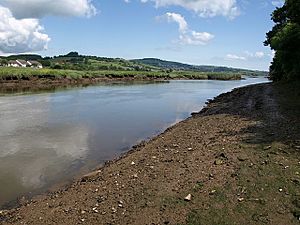Hackney Marshes, Devon facts for kids
Hackney Marshes is a special natural area in Devon, England. It's a low-lying space with grassy fields that often flood. You can find it near Kingsteignton, at the very top of the Teign Estuary. This area is protected as a local nature reserve.
Contents
A Look Back in Time: Hackney Marshes' History
From Archery to Clay Transport
Long ago, in the Middle Ages, Hackney Marshes was a place for archery practice. People would come here to shoot arrows. Later, this area became important for moving clay. Clay was dug up from places like Chudleigh Knighton, Preston, and Kingsteignton. These clay pits were very busy starting in the 1700s.
At first, workers used packhorses to carry the clay. They took it from the pits to Teignmouth, which was the closest port. This was a slow process.
The Hackney Canal and Clay Cellars
In 1843, a man named Lord Clifford owned the land. He decided to build the Hackney Canal. This canal connected a small village called Hackney to Newton Abbot. It was a big improvement for transporting clay.
The canal project included building a special tidal lock. This lock could hold two barges at once. Barges are flat-bottomed boats used for carrying goods. This made it possible to store clay in special buildings called clay cellars in Hackney. From there, the clay was loaded onto barges and carried to Teignmouth. There were 16 cellars built, able to hold 7,000 tons of clay while it waited to be moved.
The Passage House Inn
The old village of Hackney is no longer lived in. You can still see some ruins near the nature reserve. The only building still in use is the Passage House Inn, which was built in 1761. People say there has been a pub or inn on this spot since before Roman times. It was built where there used to be a tidal ford, a shallow place to cross the River Teign. This crossing gave the inn its name, "The Passage House." The canal stopped being used for trade in 1928.
Wildlife and Nature at Hackney Marshes
Home to Many Animals
As a local nature reserve, Hackney Marshes is a great home for many different kinds of wildlife. You can often see birds of prey like buzzards and kestrels flying overhead. Kestrels even use the marsh as an important place to build their nests.
Other birds you might spot include pheasants, herons, mallards, and moorhens. If you're lucky, you might even see a kingfisher with its bright blue feathers. Rare birds like the Cetti's warbler and cirl bunting also live along the waterways here.
Insects and Mammals
The beautiful wildflower meadows and ponds attract many insects. You can see colorful butterflies, speedy dragonflies, and delicate damselflies. The emerald damselfly, which is rare in Devon, can also be found here.
The marsh is also home to various small mammals. These include different kinds of mice and voles. Larger mammals like badgers and foxes also live in the area.
Trees and Plants
The woodland areas of Hackney Marshes have several types of trees. You'll find oak, alder, ash, and willow trees growing there. These trees provide shelter and food for the local wildlife.


